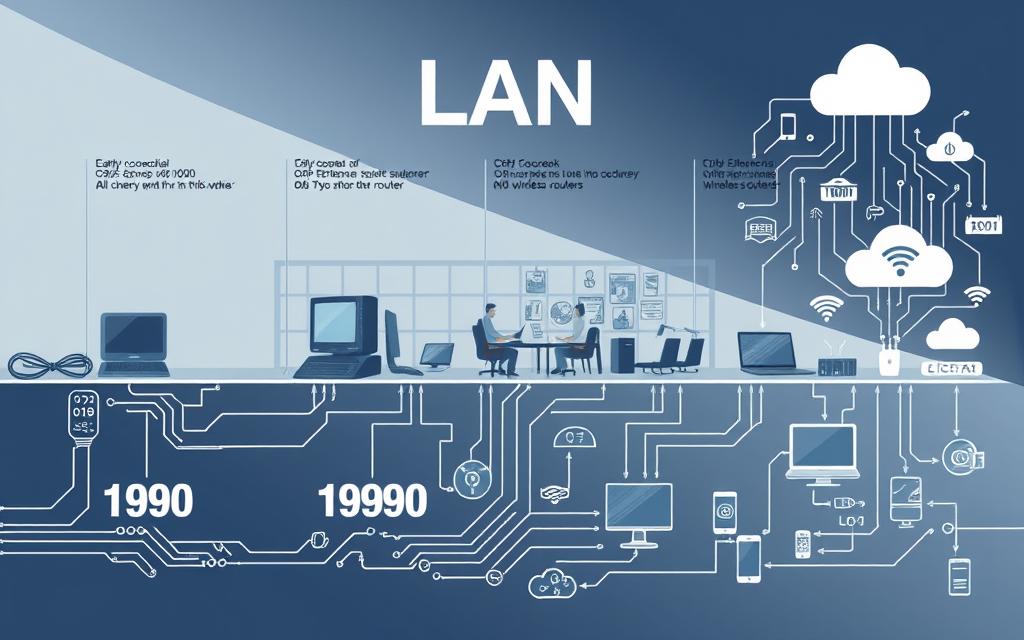What Is a LAN in Information Technology?
A Local Area Network (LAN) is key in information technology. It links many computers and devices in places like offices or universities. It uses Ethernet and Wi-Fi to allow devices to talk to each other. This includes printers and servers. LANs can serve from a small office to thousands in big companies.
LAN technology began in 1973 with Dr. Robert M. Metcalfe’s Ethernet creation. In 1977, Datapoint Corp. set up the first commercial LAN at Chase Manhattan Bank. This was a big step for networking. Over years, the IEEE set standards making Ethernet a top choice for LANs. The introduction of wireless LANs (WLANs) brought more freedom and connections in many places.
Understanding Local Area Networks (LAN)
A Local Area Network allows many devices to chat within a small area, like up to one kilometre. It’s key in places like homes, schools, and businesses.
Definition and Key Characteristics
A LAN is special because it transfers data fast, mainly using wires. Ethernet is common for these connections. Yet, Wi-Fi is becoming popular for its simple setup and use.
LANs let devices like PCs, printers, and servers talk and share with ease. You can set them up in different ways, like peer-to-peer or client-server networks. Peer-to-peer doesn’t need a central server and suits smaller setups. But, client-server networks use a main server, great for big organisations.
Developed at Xerox PARC in 1973 and made a standard by 1985, Ethernet is key for wired LANs. It allows for very fast data speeds. Today’s Gigabit Ethernet can be 100 times faster than old 10Mb/s systems.
In a LAN, you’ll find things like switches, routers, and access points. These help data move smoothly. Routers send data around the LAN, while switches make sure it gets to the right spot.
At the heart of LANs are private network IP addresses. They set the pathways for talking within the LAN. These addresses are in special ranges, crucial for managing devices in the network.
History and Evolution of LAN Technology
The history of LANs started in the 1970s. It was when Dr. Robert M. Metcalfe invented Ethernet in 1973. Ethernet was designed to link several computers and the first Xerox laser printer, laying the foundation for advanced networks. Early achievements included the first commercial LAN by Datapoint Corp at Chase Manhattan Bank in 1977. By 1979, Ethernet was available to the public, leading to its widespread use.
In the 1980s, the evolution of LAN technology sped up with new proprietary solutions. IBM’s Token Ring system was a key player, but Ethernet became the top choice in the early 1990s. Its advantages in cost and speed stood out. The shift towards wireless began in 1991, with the IEEE 802.11 standard established in 1997, marking the start of Wi-Fi.

The spread of the internet made LAN technology crucial across different sectors. Its adoption grew thanks to its role in boosting communication, teamwork, and software use in organisations. With advances in Ethernet, like CSMA/CD for avoiding signal crashes and Power over Ethernet (PoE) for easy setups, this technology kept improving. LANs now offer many setups, improving how we share resources and access data centrally, all while keeping security consistent.
What Is LAN in Information Technology
A Local Area Network, or LAN, is key for linking many devices over a small area. It’s crucial for effective communication in homes and businesses. Using Ethernet for wires or Wi-Fi for no wires, connections are made simple.
Definition and Key Characteristics
LAN supports both wired and wireless gadgets, offering flexible choices. It usually covers a few hundred metres. This makes it perfect for fast data sharing. Every gadget gets a unique IP, ensuring smooth data flow and easy access to central apps on servers.
LAN is known for its quick data sending, faster than Wide Area Networks (WAN). It’s adaptable, fitting from small home offices to big companies with thousands of people. With Ethernet, speeds can reach 1,000 Mbps. Wi-Fi, like 802.11ac, offers speeds up to 3.46 Gbps.
Types of LAN Configurations
Local Area Networks (LANs) come in two main kinds: wired and wireless setups. Each type is good for different needs and places. It’s key to know about both to make a network work best.
Wired LAN
A Wired LAN connects devices using cables. Early Ethernet could transfer data at 2 megabits per second (Mbps). Now, speeds reach up to Gigabit-per-second (Gbps) levels. With faster speeds, companies can manage more data. Technologies like Power over Ethernet (PoE) also help connect devices like cameras and phones. For businesses, Wired LANs offer secure, steady connections for easy communication.
Wireless LAN (WLAN)
Meanwhile, a Wireless LAN (WLAN) uses radio waves to move data. This means you can set up networks quickly and without cables. Today’s Wi-Fi can hit speeds up to 600 Mbps. WLANs work well at home or work, letting devices link up freely. But, they might not be as secure as wired networks. Thanks to tech like WiMax, WLANs are getting even better, linking to wider networks too. This makes them a top pick in lots of situations today.
FAQ
What is a Local Area Network (LAN)?
A Local Area Network (LAN) connects computers and devices in a small area, like a building. It allows them to communicate and share resources.
What are the main characteristics of LAN technology?
LAN technology offers fast data transfer and connects many devices. It supports wired and wireless connections. LANs typically cover up to one kilometre.
What devices can be connected to a LAN?
LANs can connect PCs, laptops, printers, servers, and IoT devices. This helps in sharing resources from a central point.
How does a LAN differ from other types of networks?
LANs are for small areas and support quick data sharing across short distances. Wide Area Networks (WANs), on the other hand, span larger distances and work differently.
What is the significance of Ethernet and Wi-Fi in LANs?
Ethernet provides a stable wired connection for LANs, supporting quick data sharing. Wi-Fi offers a wireless connection, adding flexibility to device placement.
How has LAN technology evolved over the years?
LAN technology has grown since the 1970s, starting with Ethernet. It then moved to include wireless LANs with the creation of Wi-Fi standards.
What types of LAN configurations are available?
LANs can be wired, using Ethernet cables, or wireless (WLANs), using Wi-Fi. This gives options for different needs.
What is the role of IP addresses in a LAN?
IP addresses give each device a unique label in a LAN. This makes sure data travels correctly and devices access shared resources and services.









